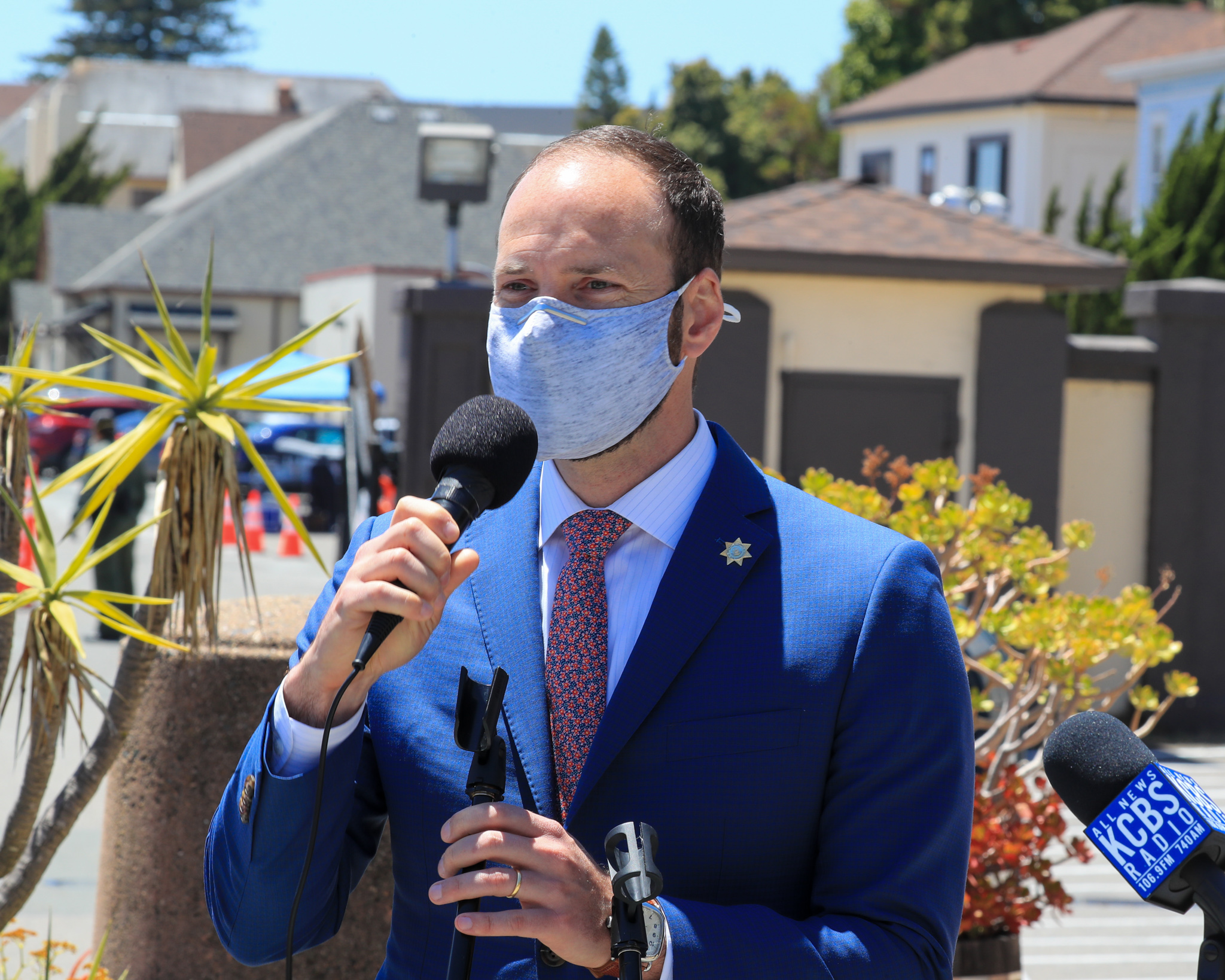

By Roxanna Jarvis and Dalia Bautista Rodriguez
SAN FRANCISCO – Despite being faced with the COVID-19 crisis just a few months after election, San Francisco District Attorney Chesa Boudin in a report by the SF DA’s office shows how the use of “Justice Driven Data” led to a decrease in crime and jail populations during this year’s pandemic.
According to DA Boudin, the purpose of the report is “to share the strategies we used to safely and rapidly decarcerate and to contextualize our work within broader goals of public safety, reducing racial inequalities, and data-driven justice.”
The report found that reductions in SF jail populations can occur without creating increases in crime and that surrounding communities could be hit much worse by COVID cases if regions fail to reduce jail populations to a reasonable amount that allows for social distancing.
When a Shelter-in-Place (SIP) order was first implemented on March 17 by SF Mayor London Breed, SF’s jail population stood at close to 1,100. The Director of Jail Health Services, Dr. Lisa Pratt, called for a reduction of the jail population by at least 400 individuals.
According to Pratt, 700-800 people would allow for social distancing in jails “to protect those who were incarcerated, San Francisco jail staff members, and the broader community.”
Over the next few weeks, the SF DA’s office worked to quickly reduce the jail population by looking over every case and focusing on releasing those most vulnerable. The DA’s office was able to  reduce the population to 699 by April 24.
reduce the population to 699 by April 24.
When the SIP was first enacted, San Francisco saw the number of arrests for thefts, robberies, and assaults drop to an all-time low since the SFPD began collecting data in 2003.
Even as the jail population decreased, rates of both property and violent crime remained below the historical average, “contradicting critics who wanted a spike in crime if our city were to rapidly decarcerate in response to COVID-19.”
The only exception to this data was the spike in residential and commercial burglaries which occurred in May, “largely driven” by protests over the murder of George Floyd.
While burglary rates have fallen, data shows that they are around 50 percent higher than rates in 2018 and 2019, the report states, adding that increases are likely “a reflection of the circumstantial nature of crime and crime rates.” Overall, San Francisco’s reported crime rate has decreased by over 33 percent since the SIP.
When reducing SF’s jail population, the DA’s office used a variety of policies to do so, including finding opportunities for alternatives to incarceration, finding community-based treatment for those suffering from mental illness, releasing those pending trial charged with misdemeanors and non-violent felonies, and only considering pre-trial detention when the facts are clear and show a likelihood that the defendant will flee or cause great bodily harm to others.
The consideration for pre-trial detention stands with the office’s policy that it should be a “last resort once all release conditions have been put to suggestions and have been determined as unsatisfactory.”
There were two policy directives brought to attention when deciding on how to safely reduce the use of incarceration, including “Pretrial Detention and Release Conditions” and “Declination of Contraband Charges Based on Pretextual Stops.”
The Pretrial Detention and Release Conditions policy introduced the fact that money bail should not be a result during an arraignment because it is discriminatory and compromises public safety. Pretrial detention should be of last resort once all release conditions have been put to suggestions and have been determined as unsatisfactory, said the DA.
Also, if the defendant is incarcerated because they cannot pay money bail, then the office cannot deny a new hearing where the issue is brought upon. If the court still detains those for money bail, then the office will not defend.
The Declination of Contraband Charges Based on Pretextual stops states that racial profiling causes a decline in trust within communities of color and causes a decrease in public safety, said the SF DA, noting it is its obligation is to protect every constitutional right of every person in San Francisco and make the system fair. The office also discourages ‘“stop and frisk”’ style policing strategies.
As the COVID crisis became larger, the target for SF’s jail population shrank to 600 in October and the DA’s office continued using the above policies to reach that recommended number.
Not only does reducing jail populations have an insignificant effort on crime rates, but it also protects the surrounding community as well.
The report included a study by ACLU Analytics in collaboration with the University of Tennessee, University of Pennsylvania, and Washington State University which proved that by not reducing jail populations, society risks increasing the number of cases and deaths in the surrounding community in addition to jails.
The study looked at the “projected increase in deaths in the broader community when mitigation efforts in jails are not conducted,” showing that projections spanned from “a 13 percent increase in community deaths in New York City to a 232 percent increase in San Bernardino.”
The consequences of inaction are shown by the example of the San Quentin virus outbreak, which was the second-largest hotspot in the country.
After transferring 121 medically vulnerable individuals from California Institution for Men (CIM) without testing them for COVID or quarantining them, an outbreak occurred. The result of failing to take precaution and social distancing was approximately 2,214 incarcerated people and 289 staff member infected, as well as 28 deaths from residents in San Quentin.
The Latinx and Black community have disproportionately become major targets for the spread of COVID-19. The jail population is 48 percent black and 40 percent white, while the city’s population is only five percent Black and 40 percent white. Black people are more likely to be killed and infected by COVID-19.
Once COVID-19 hits all around the community, then people of color are at risk. The impacts of COVID-19 can be tied to wealth and also healthcare access and the privilege others have to work from home.
These major results can be proven by a major study done in April where people living in the Mission District were highly encouraged to get tested. Of those who were tested, 38 percent identified as Caucasian and 44 percent identified as Hispanic and Latinx.
Of the ones who tested and came out positive, 95 percent were Hispanic or Latinx and zero were Caucasian. Those who tested positive did not have the privilege of working from home and they made less than $50,000 a year.
The San Francisco District Attorney’s Office is looking forward to decreasing racial divisions within the system as well the spread of COVID-19.
During the protests of George Floyd’s murder, many people decided to join DA Boudin to take a stand for racial justice. The report states tht ‘“systemic discrimination manifested in inequitable social, environmental, economic, and criminal justice policies, practices, and investments.”
The office’s focus is to find ways to reduce the jail population and put more effort into policies that will help reduce incarceration rates. Data collected from March to April indicates that this is possible without causing major spikes in crime rates.
With the publishing of the report, the SF DA’s office hopes it will “promote transparency and support other jurisdictions in taking the critical measures needed to reduce their jail populations and prevent avoidable deaths.”
 Roxanna Jarvis is a fourth-year student at UC Berkeley, currently majoring in Political Science with a minor in Public Policy. She is from
Roxanna Jarvis is a fourth-year student at UC Berkeley, currently majoring in Political Science with a minor in Public Policy. She is from  Sacramento, California.
Sacramento, California.
Dalia Bautista Rodriguez is a third-year transfer at UC Davis and majoring in Community & Regional Development. She is originally from Guadalupe, CA.
To sign up for our new newsletter – Everyday Injustice – https://tinyurl.com/yyultcf9
Support our work – to become a sustaining at $5 – $10- $25 per month hit the link: